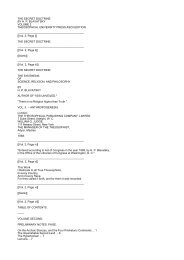You also want an ePaper? Increase the reach of your titles
YUMPU automatically turns print PDFs into web optimized ePapers that Google loves.
The Versions Of The <strong>Book</strong> Of The <strong>Dead</strong>.<br />
<strong>of</strong> Mycerinus; we have also seen from a number <strong>of</strong> mastabas and stelæ that <strong>the</strong> funeral ceremonies<br />
connected with <strong>the</strong> <strong>Book</strong> <strong>of</strong> <strong>the</strong> <strong>Dead</strong> were performed certainly in <strong>the</strong> IInd, and with almost equal<br />
certainty in <strong>the</strong> Ist dynasty. It is easy to show that certain sections <strong>of</strong> <strong>the</strong> <strong>Book</strong> <strong>of</strong> <strong>the</strong> <strong>Dead</strong> <strong>of</strong> this period<br />
were copied and used in <strong>the</strong> following dynasties down to a period about A.D. 200.<br />
The <strong>Book</strong> <strong>of</strong> <strong>the</strong> <strong>Dead</strong> a collection <strong>of</strong> separate works.<br />
The fact that not only in <strong>the</strong> pyramids <strong>of</strong> Unas and Teta, but also in those <strong>of</strong> Pepi I. and his immediate<br />
successors, we find selected passages, suggests that <strong>the</strong> <strong>Book</strong> <strong>of</strong> <strong>the</strong> <strong>Dead</strong> was, even in those early times,<br />
so extensive that even a king was fain to make from it a selection only <strong>of</strong> <strong>the</strong> passages which suited his<br />
individual taste or were considered sufficient to secure his welfare in <strong>the</strong> next world. In <strong>the</strong> pyramids <strong>of</strong><br />
Teta, Pepi I., Mer-en-Ra and Pepi II. are found many texts which are identical with those employed by<br />
<strong>the</strong>ir predecessors, and an examination <strong>of</strong> <strong>the</strong> inscription <strong>of</strong> Pepi II. will show that about three-fourths <strong>of</strong><br />
<strong>the</strong> whole may be found in <strong>the</strong> monuments <strong>of</strong> his ancestors. What principle guided each king in <strong>the</strong><br />
selection <strong>of</strong> his texts, or whe<strong>the</strong>r <strong>the</strong> additions in each represent religious developments, it is impossible<br />
to say; but, as <strong>the</strong> Egyptian religion cannot have remained stationary in every particular, it is probable<br />
that some texts reflect <strong>the</strong> changes in <strong>the</strong> opinions <strong>of</strong> <strong>the</strong> priests upon matters <strong>of</strong> doctrine.[1] The<br />
"Pyramid Texts" prove that each section <strong>of</strong> <strong>the</strong> religious books <strong>of</strong> <strong>the</strong> Egyptians was originally a separate<br />
and independent composition, that it was written with a definite object, and that it might be arranged in<br />
any order in a series <strong>of</strong> similar texts. What preceded or what followed it was never taken into<br />
[1. A development has been observed in <strong>the</strong> plan <strong>of</strong> ornamenting <strong>the</strong> interiors <strong>of</strong> <strong>the</strong> pyramids <strong>of</strong> <strong>the</strong> Vth and VIth<br />
dynasties. In that <strong>of</strong> Unas about one-quarter <strong>of</strong> <strong>the</strong> sarcophagus chamber is covered with architectural decorations, and <strong>the</strong><br />
hieroglyphics are large, well spaced, and enclosed in broad lines. But as we advance in <strong>the</strong> VIth dynasty, <strong>the</strong> space set<br />
apart for decorative purposes becomes less, <strong>the</strong> hieroglyphics are smaller, <strong>the</strong> lines are crowded, and <strong>the</strong> inscriptions<br />
overflow into <strong>the</strong> chambers and corridors, which in <strong>the</strong> Vth dynasty were left blank. See Maspero in Revue des Religions,<br />
t. xi., p. 124.]<br />
{p. xxv}<br />
consideration by <strong>the</strong> scribe, although it seems, at times, as if traditions had assigned a sequence to certain<br />
texts.<br />
Historical reference.<br />
That events <strong>of</strong> contemporary history were sometimes reflected in <strong>the</strong> <strong>Book</strong> <strong>of</strong> <strong>the</strong> <strong>Dead</strong> <strong>of</strong> <strong>the</strong> early<br />
dynasties is proved by <strong>the</strong> following. We learn from <strong>the</strong> inscription upon <strong>the</strong> tomb <strong>of</strong> Heru-khuf at<br />
Aswân,[l] that this governor <strong>of</strong> Elephantine was ordered to bring for king Pepi II.[2] a pigmy,[3] from <strong>the</strong><br />
interior <strong>of</strong> Africa, to dance before <strong>the</strong> king and amuse him; and he was promised that, if he succeeded in<br />
bringing <strong>the</strong> pigmy alive and in good health, his majesty would confer upon him a higher rank and<br />
dignity than that which king Assa conferred upon his minister Ba-ur-Tettet, who performed this much<br />
appreciated service for his master.[4] Now Assa was <strong>the</strong> eighth king <strong>of</strong> <strong>the</strong> Vth dynasty, and Pepi II. was<br />
<strong>the</strong> fifth king <strong>of</strong> <strong>the</strong> VIth dynasty, and between <strong>the</strong> reigns <strong>of</strong> <strong>the</strong>se kings <strong>the</strong>re was, according to M.<br />
Maspero, an interval <strong>of</strong> at least sixty-four, but more probably eighty, years. But in <strong>the</strong> text in <strong>the</strong> pyramid<br />
<strong>of</strong> Pepi I., which must have been drafted at some period between <strong>the</strong> reigns <strong>of</strong> <strong>the</strong>se kings, we have <strong>the</strong><br />
passage, "Hail thou who [at thy will] makest to pass over to <strong>the</strong> Field <strong>of</strong> Aaru <strong>the</strong> soul that is right and<br />
true, or dost make shipwreck <strong>of</strong> it. Ra-meri (i.e., Pepi I.) is right and true in respect <strong>of</strong> heaven and in<br />
respect <strong>of</strong> earth, Pepi is right and true in respect <strong>of</strong> <strong>the</strong> island <strong>of</strong> <strong>the</strong> earth whi<strong>the</strong>r he swimmeth and<br />
where he arriveth. He who is between <strong>the</strong> thighs <strong>of</strong> Nut (i.e., Pepi) is <strong>the</strong> pigmy who danceth [like] <strong>the</strong><br />
http://www.sacred-texts.com/egy/ebod/ebod03.htm (13 <strong>of</strong> 36) [8/10/2001 11:22:55 AM]

















